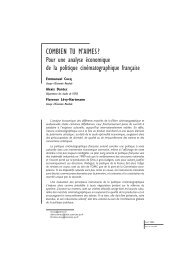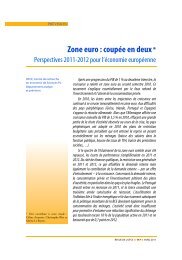direct multi-step estimation and forecasting - OFCE - Sciences Po
direct multi-step estimation and forecasting - OFCE - Sciences Po
direct multi-step estimation and forecasting - OFCE - Sciences Po
Create successful ePaper yourself
Turn your PDF publications into a flip-book with our unique Google optimized e-Paper software.
Direct <strong>multi</strong>-<strong>step</strong> <strong>estimation</strong> <strong>and</strong> <strong>forecasting</strong><br />
The significant aspect is that the maximum likelihood estimate of α is that of α 2 too.<br />
Johnston, Klein, <strong>and</strong> Shinjo compare several <strong>forecasting</strong> methods for the AR(1) with different<br />
parameter values <strong>and</strong> apply their techniques to the Wharton model. Their idea is to compute<br />
estimators <strong>and</strong> resulting forecasts which incorporate the dynamic structure of the data generating<br />
process. The hypothesis is that ‘systems using up to pth order generated lag values as instruments<br />
or regressors will perform best in p period point prediction’. In general, the DLS estimator for a<br />
model such as<br />
A (L) y t = ɛ t ,<br />
where A (L) is a matrix polynomial <strong>and</strong> L the lag operator, is that which minimizes the criterion:<br />
tr ∑ T<br />
t=1<br />
(A (L) −1 ɛ t<br />
) (<br />
A (L) −1 ɛ t<br />
) ′<br />
.<br />
In the univariate AR(1) case from (4), this is:<br />
∑ T (<br />
˜α = argmin yt − y 0 α t) 2<br />
. (5)<br />
α t=1<br />
The procedure used by the authors for actual minimization is a grid search. The results of Monte<br />
Carlo simulations with fixed or stochastic initial values <strong>and</strong> various stationary values of α show that<br />
the variance of the DLS estimator is higher than that of OLS when the initial value is stochastic,<br />
but lower for a fixed initial value. In terms of mean-square forecast error (MSFE), their results are<br />
that for small samples (either 20 or 50 observations <strong>and</strong> the forecast horizons, respectively, of 5 or<br />
10 periods) DLS outperforms OLS when the initial value is fixed, but when the latter is stochastic,<br />
the forecast loss is lower for DLS only for very small samples.<br />
The authors then use Two-Stage Least Squares estimators for the Wharton model. They match<br />
the values of the lag used for the endogenous variable as an instrument <strong>and</strong> the horizon at which<br />
it is desired to forecast. Unfortunately, their results for out-of-sample prediction are somewhat<br />
inconclusive. Some gains are obtained at short horizons <strong>and</strong> seem to improve with the lead in the<br />
forecast for Personal Income <strong>and</strong> Total Consumption but not for the G.N.P. deflator, Investment<br />
in Non-farm inventories <strong>and</strong> Unemployment rate.<br />
The G.N.P. deflator is the only variable for<br />
which the within-sample residual st<strong>and</strong>ard error <strong>and</strong> the post-sample root-MSFE are of the same<br />
magnitude. The latter is much larger than the former as regards the other variables.<br />
8








